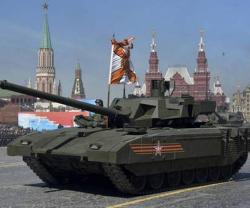Russia’s state-of-the-art T-14 tank, part of the Armata family of armored combat vehicles, is already being mass produced, according to the US magazine The National Interest.
Dave Majumdar, Defense Editor of the US magazine The National Interest, quoted a top Russian defense industry executive as saying that Russia’s Armata family of combat vehicles, including the advanced T-14 tank, is already in serial production.
According to Majumdar, the news will certainly come as a surprise for many Western analysts who “believed that the Armata family was still in its developmental stages” after its new models took part in the 2015 Victory Day parade in Moscow (photo).
He referred to Sergey Chemezov, head of the Russian state corporation Rostec, who confirmed in an interview with the Wall Street Journal that the T-14 is already being mass produced.
Although “Moscow reduces its defense outlays as oil revenues suffer” the Armata main battle tank project will never be put on hold, Majumdar cited Chemezov as saying.
“You can’t quit when you're halfway there. Everything that has been started will be finished, and money will be allocated to it,” Chemezov said, adding that as for the T-14, “it’s already in serial production.”
Majumdar, for his part, recalled that apart from the T-14, the Armata Universal Combat Platform includes the T-15 heavy infantry fighting vehicle, the T-16 armored recovery vehicle and an upgunned heavy assault armored vehicle, which Majumdar said has already been dubbed “the Tank Killer” by Russian media.
As far as the T-14 is concerned, it is “a source of major concern for Western armies,” including the German Armed Forces, according to Majumdar.
“As a direct response to the development of the T-14, Germany recently launched an effort to upgun the Leopard 2 with a new 130mm cannon and is developing plans to launch a new main battle tank called the Main Ground Combat System (MGCS),” he said.
The Armata tank features sophisticated weaponry, a remote control turret and outer armor that explodes on impact to prevent shells from reaching the crew inside.
The tank’s interior features a capsule that keeps the crew isolated from ammunition and fuel, which could increase the chances for the crew's survival if the tank is hit.
A digital control system directs the tank's movement, tracks targets and activates its defense systems, freeing the crew from routine tasks so they can focus on key combat functions. Currently, the tank sports the standard 125-mm cannon, but, designers say, it could easily outfitted with a much more powerful 152-mm cannon in the future.






















